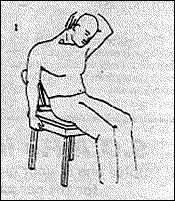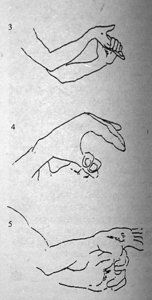New York's highest court of appeals has held that no-fault insurers cannot deny no-fault benefits where they unilaterally determine that a provider has committed misconduct based upon alleged fraudulent conduct. The Court held that this authority belongs solely to state regulators, specifically New York's Board of Regents, which oversees professional licensing and discipline. This follows a similar recent ruling in Florida reported in this publication.
Cumulative Therapy -- Continued
The following exercises have been found to be extremely helpful in reducing the stress of muscle tension in a setting that has predominantly wrist and elbow problems. The stressful motions in using a tool called the "Hog Ring Gun" are in the wrist extensor groups, as well as a substantial amount of ulnar deviation. This tool is not extremely well balanced and becomes lighter as the staples are used up and then heavier when the gun is loaded again. There is some pressure involved with pushing the "gun" into the material that is being fastened. There is, of course, a substantial amount of neck flexion and stressors on the shoulder musculature, particularly the infraspinatus and levator scapula muscles as well. The following exercises are given and recommended to be used prior to work, during break times, and after work. These exercises have been deemed useful by employees and have a reasonable amount of compliance among workers.

Figure 1: Sitting in a low-back chair with neck and shoulders relaxed, the hand on the affected side stabilizes on chair. The opposite hand pulls the head forward and sideways, whichever way the muscle feels tightest.

Figure 2: Lying flat on the back in bed with the hand of the affected side tucked under buttocks, use the opposite hand to pull the head, with the nose towards, away from, and in neutral position of the face, where each has the tightest muscle fibers. Use gentle, smooth pulling of ear to shoulder.

Figure 3: Extensor muscle stretch of forearm begins with the inside part (anticubital fossa) facing up and the hand palm down, with elbow resting on table. The hand is stretched downward and to the little finger side, with steady pressure holding on those spots that are tighter.
Figure 4: Sitting in a chair with arm outstretched, palm up and elbow resting on chair or knee, the forearm is stretched by steady, gentle pressure to push the hand down towards the floor. (Placing a hot moist towel on anterior elbow ten minutes before stretching will make stretch better.)
Figure 5: Thumb stretch is done by pulling the thumb at a 45-degree angle, downward and backward, for the count of ten. Also, it should be pulled straight sideways for another count of ten.
Figure 6: Triceps stretch is done by fully flexing the elbow and placing your hand as far down the shoulder blade as possible. Then lean against the wall, stretching the muscle by pushing armpit with steady, gentle pressure into the wall.
Figure 7: The triceps stretch is done by fully flexing the elbow and placing the hand as far down the shoulder blade as possible. Then lean against the wall, stretching the muscle by pushing the armpit into the wall with steady, gentle pressure.
Figure 8: The Hog-Ring stretch is done by pulling the thumb downward and to the thumb-side of the wrist.
Figure 9: Sitting in a chair with outstretched arm, palm up and elbow resting on knee, the forearm stretch is done by applying steady gentle pressure to push the hand down towards the floor. (Placing a warm, moist towel on the anterior elbow for ten minutes before stretching will make stretch easier.)
Figure 10: The thumb stretch is done by pulling the thumb down at about a 45-degree angle to the wrist.
Figure 11: The door stretch starts with the hands at waist level, body leaning into the doorway to stretch the anterior portion of the upper chest muscles. Standing with the back against the wall, with arms outstretched as if around a tree, a rubber band is pulled to maximum contraction to the count of five, held for the count of two, and then slowly released to the count of five. This is done at least five times.



